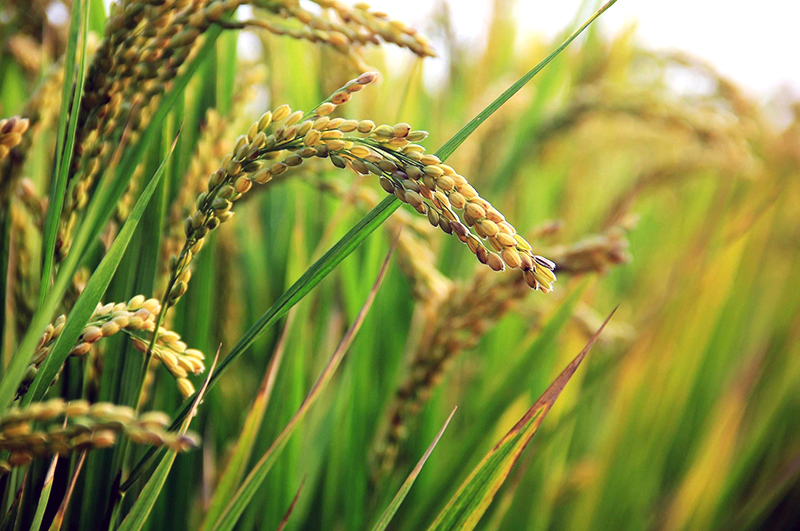
Regenerative Alternatives to Burning the Rice Fields
by Sheryl Karas MA, CRARS Staff

Old-timers in Butte County certainly remember the rice fields being burned in the spring and fall every year. The region would be so filled with smoke that the nearby foothills at the time could not be seen. People who suffer with allergies and asthma would particularly dread those annual burns. 80% of rice farmers locally used to do this to control weeds and pests and because crop yields seem to improve in the season immediately after burning. It is also attractive to farmers because it is far less time consuming and easier than other methods of dealing with farm waste.
Unfortunately air quality in the county (and in the Sacramento Valley as a whole) is quite poor, exceeding standards for ozone (O3) in the summer, and particulate matter (PM) 2.5 in the winter. Some of this is due to topography and wind patterns pushing pollution from the Bay Area and Sacramento northwards into the valley, and pulling smoke from wildfires in from all around. But enough of it is from agriculture that the state legislature worked with the California Rice Commission to pass legislature, particularly in 1991 and 2001, to phase down rice agricultural burns. Today, rice burning has been reduced to between 10 - 25% for farmers who can show they need it for disease control.
As a result, rice growers have had to seek alternatives to rice burning. For many this has been quite the challenge; but some farmers using more regenerative techniques have started to see this as an opportunity.
The Importance of Regenerative Agriculture for Growing Rice
In addition to air quality, there are other significant costs to rice burning. Mohammad Esmaeil Asadi, Associate Professor of Water Engineering and Management at the Asian Institute of Technology in Bangkok, Thailand recently described rice burning as a “needless way to lose money(opens in new window).” Erosion of soil quality and climate change are two factors driving a lot of the discussion in agriculture these days. Asadi says that rice residue is a good source of soil nutrients. When it is burned most of the carbon and nitrogen and much of the phosphorus and potassium is released into the atmosphere causing air pollution and affecting human health. 74-100% of the carbon is lost in the form of CO2 and CO, gasses that contribute to global warming, instead of being stored and used in the soil. (According to Project Drawdown(opens in new window), conventional rice cultivation is responsible for at least 10 percent of agricultural greenhouse gas emissions.)
Additionally, Asadi says that burning the rice fields kills all microorganisms and soil fauna located on or near the surface. Those living creatures are responsible for turning dirt into healthy soil capable of growing healthy—and prosperous—food crops. The value of soil biodiversity has been estimated at between $1.5 – 13 trillion a year worldwide(opens in new window). In regenerative agriculture, efforts are made to preserve and nurture soil biology. For example, in Thailand, Asadi says farmers are experimenting with no-till planters that directly sow seed into plant residues. They also attempt to grow a diversity of living plants year round to keep the soil covered and provide nutrients to soil microbes through living roots.
Trent Roberts(opens in new window), soil fertility specialist with the University of Arkansas, has been working with an NRCS Conservation Innovation grant to explore alternatives to burning rice in Arkansas. He says one of the best approaches his team found was to roll down the rice stubble following the rice harvest and plant cover crops no-till into the residue. They’ve found the most success there with cereal rye, Austrian winter pea and black oats.
Local Rice Farmers Experimenting with Regenerative Techniques
Here in northern California, Hossein Zakeri, Chico State Assistant Professor of Agriculture and faculty affiliate with the Center for Regenerative Agriculture & Resilient Systems (CRARS), has been studying the use of fava beans as a nitrogen-fixing cover crop that could do double duty as a highly nutritious food crop in rice fields. He and postdoctoral researcher Kyle Brasier are spearheading multiple trials. One will be with local rice grower, Lundberg Family Farm(opens in new window).
The Lundbergs(opens in new window) have been growing rice for three generations. Albert, the Lundberg patriarch who pioneered growing rice organically in California, grew up seeing the devastation of the Dust Bowl. He impressed on his sons the importance of soil conservation, and they stopped burning their fields in the 1960s. Instead they return the rice straw to the soil after harvest, practice crop rotation, and use nitrogen-fixing cover crops. The fava bean project they are participating in with Chico State will be conducted over multiple growing seasons to quantify the economic benefits of fresh fava bean pod harvests and soil health.
CRARS graduate student Raquel Krach and her husband Greg Massa have also been working on growing rice using regenerative methods. They don’t burn their crop residues and choose to farm organically. But with modern rice varieties bred for high inputs of nitrogen and herbicides to kill weeds, this is a very challenging choice. At Massa Organics(opens in new window) they use crop rotation, cover crops, field preparation, timely planting, and deep water followed by drought stress to restrain weeds. Krach decided to pursue graduate work in regenerative agriculture to learn the science of the physical, chemical, and biological processes at work in regenerative practices. She’s looking forward to participating in research to advance the field.
